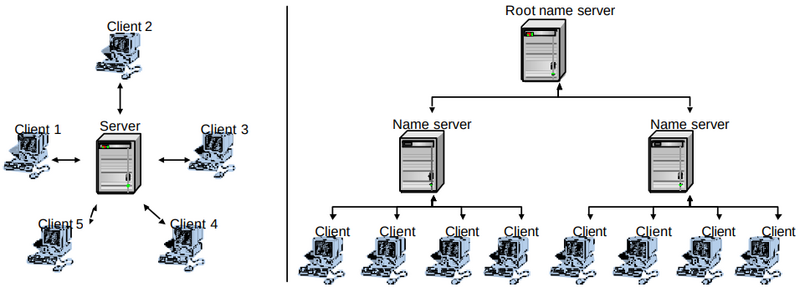Distributed Client-Server Computing System
(Redirected from Client-Server Application)
Jump to navigation
Jump to search
A Distributed Client-Server Computing System is a distributed computing system that follows a client-server architecture (which partitions tasks or workloads between a server (a provider of a resource or service) and a client/service requester).
- AKA: Centralized Client-Server Computing System,.
- Context:
- It can range from a Flat Client-Server Computing System to being a Hierarchical Client-Server Computing System.
- It can (typically) follow a Client-Server Architecture (with one or more client programs and one or more server programs).
- …
- Example(s):
- Counter-Example(s):
- See: Computer Network, Host (Network), Email, Network Printing, Networked Program, Networked DBMS.
References
2021a
- (Wikipedia, 2021) ⇒ https://en.wikipedia.org/wiki/Distributed_computing#Architectures Retrieved:2021-10-2.
- Various hardware and software architectures are used for distributed computing. At a lower level, it is necessary to interconnect multiple CPUs with some sort of network, regardless of whether that network is printed onto a circuit board or made up of loosely coupled devices and cables. At a higher level, it is necessary to interconnect processes running on those CPUs with some sort of communication system.[1]
- Client–server: architectures where smart clients contact the server for data then format and display it to the users. Input at the client is committed back to the server when it represents a permanent change.
- (...)
- Various hardware and software architectures are used for distributed computing. At a lower level, it is necessary to interconnect multiple CPUs with some sort of network, regardless of whether that network is printed onto a circuit board or made up of loosely coupled devices and cables. At a higher level, it is necessary to interconnect processes running on those CPUs with some sort of communication system.[1]
- ↑ Ohlídal, M.; Jaroš, J.; Schwarz, J.; et al. (2006). “Evolutionary Design of OAB and AAB Communication Schedules for Interconnection Networks". In Rothlauf, F.; Branke, J.; Cagnoni, S. (eds.). Applications of Evolutionary Computing. Springer Science & Business Media. pp. 267–78. ISBN 9783540332374.
2021b
- (Wikipedia, 2021) ⇒ https://en.wikipedia.org/wiki/Client–server_model Retrieved:2021-10-2.
- Client–server model is a distributed application structure that partitions tasks or workloads between the providers of a resource or service, called servers, and service requesters, called clients. Often clients and servers communicate over a computer network on separate hardware, but both client and server may reside in the same system. A server host runs one or more server programs, which share their resources with clients. A client usually does not share any of its resources, but it requests content or service from a server. Clients, therefore, initiate communication sessions with servers, which await incoming requests.
Examples of computer applications that use the client–server model are email, network printing, and the World Wide Web.
- Client–server model is a distributed application structure that partitions tasks or workloads between the providers of a resource or service, called servers, and service requesters, called clients. Often clients and servers communicate over a computer network on separate hardware, but both client and server may reside in the same system. A server host runs one or more server programs, which share their resources with clients. A client usually does not share any of its resources, but it requests content or service from a server. Clients, therefore, initiate communication sessions with servers, which await incoming requests.
2003
- (Maly et al., 2003) ⇒ Robin Jan Maly, Jan Mischke, Pascal Kurtansky, and Burkhard Stiller (2003). "Comparison of Centralized (Client-Server) and Decentralized (peer-to-peer) Networking". In: Semester thesis, ETH Zurich, Zurich, Switzerland, 1-12.
- QUOTE: (...) Client-Server architectures can be classified into flat and hierarchical. If the Client-Server model is flat, all clients communicate only with a single server, see Figure 4. If the Client-Server model is hierarchical the servers of one level are acting as clients to higher level servers. A pretty good example is a request of a certain web page. The user enters a URL into the web browser (client). The client establishes a connection to his nearest name server to ask for the address. If that server does not know the name, it delegates the query to the authority for that namespace. That query, in turn, may be delegated to a higher authority, all the way up to the root name servers for the Internet as a whole. Name servers operate both as clients and as servers, see Figure 4.

|
2000a
- (Nieh et al., 2000) ⇒ Jason Nieh, S. Jae Yang, and Naomi Novik (2000). "A Comparison of Thin-Client Computing Architectures", In: Technical Report CUCS-022-00. Columbia - Academic Commons. DOI:10.7916/D8Z329VF.
- QUOTE: The goal of the thin-client model is to centralize computing resources, with all the attendant benefits of easier maintenance and cheaper upgrades, while maintaining the same quality of service for the end user that could be provided by a dedicated workstation. In a thin-client computing environment, end users move from full-featured computers to thin clients, lightweight machines primarily used for display and input and which require less maintenance and fewer upgrades. Organizations then provide computing services to their end users' thin clients from high-powered servers over a network connection. Server resources can be shared across many users, resulting in more effective utilization of computing hardware.
2000b
- (Reese, 2000) ⇒ George Reese (2000). "Chapter 7: Distributed Application Architecture". In: "Database Programming with JDBC and JAVA". O'Reilly Media, Inc. ISBN:1-56592-616-1.
- QUOTE: Client/server is often a generic umbrella term for any application architecture that divides processing among two or more processes, often on two or more machines. Any database application is a client/server application if it handles data storage and retrieval in the database process and data manipulation and presentation somewhere else. The server is the database engine that stores the data, and the client is the process that gets or creates the data. The idea behind the client server architecture in a database application is to provide multiple users with access to the same data.